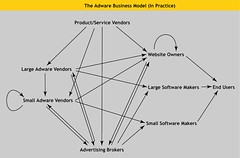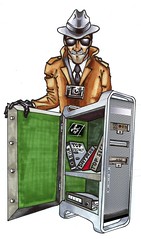Payware
Thinstall
Thinstall operates on binary data such as EXEs, DLLs, datafiles, and registry information to create self-contained applications that can be deployed and executed without installation. Thinstall does not require any source code changes. Click here for more details about How Thinstall fits into your software release process.

Virtual Machine Technology (VM)

Click here to enlarge
Thinstall's Virtual Machine Technology allows developers to package entire applications into a single file that can be run without an installation process. Thinstall's Virtual Machine Technology is extremely light weight in terms of the amount of disk space, RAM, and CPU it requires.
The Virtual Machine (VM) performs:
| · | Process Loading. The VM loads a starting EXE file from the Virtual Filesystem and allows it to execute any other EXE directly from the Virtual Filesystem or from the normal filesystem.
|
| · | DLL Loading. The VM loads any DLL dependencies your EXE/DLL/OCX files may have directly from archive when instructed. The VM can import and use DLLs located on the normal filesystem as well as the Virtual File System. The VM provides full control over which DLLs you want to use, making it possible to entirely eliminate "DLL Hell" problems without relying on Windows XP "Side-by-side" features.
|
| · | Thread & Process Management. The VM is responsible for keeping track of all threads created inside the virtual machine. The VM manages thread-local storage, notifies Dlls about new process threads, and manages memory for thread stacks.
|
| · | The VM runs on all versions of 32bit, Windows platforms (95/98/ME/NT/2k/XP) without installation, drivers, reboots, or administrator access.
|
Virtual File System (VFS)
The Virtual File System (VFS) presents a "merged" view of package archive files and system files.
| · | VFS is always compressed on disk, meaning your installed disk footprint is the same as the pre-install footprint.
|
| · | VFS provides transparent decompression for files accessed inside the VFS.
|
| · | VFS provides transparent encryption/decryption for file writes/reads inside the VFS.
|
| · | VFS allows all processes and libraries loaded through the VM to access files from both the VFS and the normal filesystem.
|
| · | The VFS presents a "merged view" of the filesystem to applications run by the VM. Files from both systems can appear in the same directory.
|
| · | The VFS works with any underlying filesystem, including FAT32, NTFS, Network shares, and any future filesystem.
|
Virtual Registry / COM / ActiveX (VREG)

The Virtual Registry presents predefined registry keys to all applications and libraries loaded through the VOS.
| · | Virtual registry allows COM/ActiveX based applications to run on systems where registry access has been restricted.
|
| · | Supports In-Process (DLL/OCX) and Out-of-process (EXE) servers.
|
| · | COM and ActiveX controls can be loaded directly from the VFS, eliminating all possibility of removal by another application's uninstall.
|
| · | Virtual Registry exists inside your EXE, so it cannot be misconfigured by another program's installer or uninstaller.
|
| · | Registry recording system allows you to record all registry keys a COM/ActiveX control would normally create during "Regsvr32". Recording occurs on the development computer, and is simulated in the runtime environment.
|
| · | The VREG system automatically tracks COM object lifetimes so that it can free DLL and EXE servers.
|
Integrated Installer
| · | Install/Uninstall remains integrated with your EXE
|
| · | Allow the user to chose the installation directory
|
| · | Add Startmenu shortcuts to launch or uninstall your program or link to websites
|
| · | Add a desktop shortcut to your program
|
| · | Add a control panel uninstall option in Add/Remove Programs
|
| · | Display a custom BMP file in the installation dialog
|
| · | Warn users when they try to run a different version from the one installed.
|
| · | Display a license agreement window before running the application
|
| · | Install options can be made automatic so no user interaction is required to install.
|
Program Security
| · Packaged applications are protected from disassembly, reverse engineering, and disk patching to a high degree
|
| · Packaged datafiles are protected from user inspection, and writes to datafiles can be cached with transparent encryption.
|
| How Thinstall works, supported platforms, and performance effects
|
Virtual Machine, Virtual File System, Virtual Registry
EXE/DLL Resources
| Icons, Version Information, and XP Styles
|
Program Installation
| Adding Start Menu Shortcuts, Use with 3rd Party Installers, Use with Patching Software
|
Licensing & Trial Demos
| License your software, generate license keys, and restrict access to your data & files.
|
Program Security
| Stop debuggers and protect your application
|
Scripting
| Perform additional actions during Install, etc, Script API Reference.
|
Language Localization
| Displaying Thinstall strings in the user's native language (English, Chinese, etc).
|
Project files
How to transport your project files from one computer to another computer
Command-line version
| Automate your build process
|
.NET
| .NET Framework Linking, Service Apps, Updating, Common .NET Questions
|
Visual Basic
| VB Specific features, Common VB Questions & Tips
|
Activity Logging
Find out what your application does and why it might fail


![Reblog this post [with Zemanta]](http://img.zemanta.com/reblog_e.png?x-id=3d6ef399-da89-4303-a562-c2df714fa25a)
Marcadores: Lua, Microsoft, PayWare, Portable, Programming, Release, Software, Thinstall, Virtual, Windows
# 6/11/2009 08:51:00 PM, Comentários, Links para esta postagem,
adware
 Image by Esthr via Flickr
Image by Esthr via Flickr
adware
Software which is free to download and use but includes pop-up banner ads somewhere. See also {-ware}.![Reblog this post [with Zemanta]](http://img.zemanta.com/reblog_c.png?x-id=d35a3735-c8c5-4f50-b6f0-a64e8d8fd546)
Marcadores: AdWare, AnnoyWare, CareWare, CrippleWare, CrudWare, FreeWare, FritterWare, GuiltWare, LiveWare, MeatWare, PayWare, PsychedelicWare, ShareWare, ShelfWare, SpyWare, VaporWare, WetWare
# 5/19/2009 01:31:00 PM, Comentários, Links para esta postagem,
-ware
-ware
[from software
] Commonly used to form jargon terms for classes of software. For examples, see:
- {annoyware},
- {careware},
- {crippleware},
- {crudware},
- {freeware},
- {fritterware},
- {guiltware},
- {liveware},
- {meatware},
- {payware},
- {psychedelicware},
- {shareware},
- {shelfware},
- {vaporware},
- {wetware},
- {spyware},
- {adware}.

Marcadores: AdWare, AnnoyWare, CareWare, CrippleWare, CrudWare, FreeWare, FritterWare, GuiltWare, LiveWare, MeatWare, PayWare, PsychedelicWare, ShareWare, ShelfWare, SpyWare, VaporWare, WetWare
# 5/07/2009 11:31:00 PM, Comentários, Links para esta postagem,
soft-ware
 Image by Sophos D/A/CH Presseinfo via Flickr
Image by Sophos D/A/CH Presseinfo via Flickr
- -ware: suff.
-
[from 'software'] Commonly used to form jargon terms for classes of software. For examples, see, annoyware, careware, crippleware, crudware, freeware, fritterware, guiltware, liveware, meatware, payware, psychedelicware, shareware, shelfware, vaporware, wetware, spyware, adware.
-

Marcadores: AdWare, AnnoyWare, CareWare, CrippleWare, CrudWare, FreeWare, FritterWare, GuiltWare, LiveWare, MeatWare, PayWare, PsychedelicWare, ShareWare, ShelfWare, Software, SpyWare, VaporWare, WetWare
# 4/29/2009 01:57:00 AM, Comentários, Links para esta postagem,

Ware Stuff
 Image by Sophos D/A/CH Presseinfo via Flickr
Image by Sophos D/A/CH Presseinfo via Flickr
- -ware: suff.
-
[from 'software'] Commonly used to form jargon terms for classes of software. For examples, see, annoyware, careware, crippleware, crudware, freeware, fritterware, guiltware, liveware, meatware, payware, psychedelicware, shareware, shelfware, vaporware, wetware, spyware, adware.
-

Marcadores: AdWare, AnnoyWare, CareWare, CrippleWare, CrudWare, FreeWare, FritterWare, GuiltWare, LiveWare, MeatWare, PayWare, PsychedelicWare, ShareWare, ShelfWare, SpyWare, VaporWare, WetWare
# 4/29/2009 01:45:00 AM, Comentários, Links para esta postagem,
